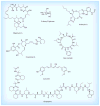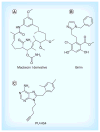Alternative approaches to Hsp90 modulation for the treatment of cancer
- PMID: 25367392
- PMCID: PMC4406230
- DOI: 10.4155/fmc.14.89
Alternative approaches to Hsp90 modulation for the treatment of cancer
Abstract
Hsp90 is responsible for the conformational maturation of newly synthesized polypeptides (client proteins) and the re-maturation of denatured proteins via the Hsp90 chaperone cycle. Inhibition of the Hsp90 N-terminus has emerged as a clinically relevant strategy for anticancer chemotherapeutics due to the involvement of clients in a variety of oncogenic pathways. Several immunophilins, co-chaperones and partner proteins are also necessary for Hsp90 chaperoning activity. Alternative strategies to inhibit Hsp90 function include disruption of the C-terminal dimerization domain and the Hsp90 heteroprotein complex. C-terminal inhibitors and Hsp90 co-chaperone disruptors prevent cancer cell proliferation similar to N-terminal inhibitors and destabilize client proteins without induction of heat shock proteins. Herein, current Hsp90 inhibitors, the chaperone cycle, and regulation of this cycle will be discussed.
Figures







Similar articles
-
Hsp90: Friends, clients and natural foes.Biochimie. 2016 Aug;127:227-40. doi: 10.1016/j.biochi.2016.05.018. Epub 2016 Jun 11. Biochimie. 2016. PMID: 27295069 Review.
-
Novobiocin and additional inhibitors of the Hsp90 C-terminal nucleotide-binding pocket.Curr Med Chem. 2008;15(26):2702-17. doi: 10.2174/092986708786242895. Curr Med Chem. 2008. PMID: 18991631 Free PMC article. Review.
-
Cucurbitacin D Is a Disruptor of the HSP90 Chaperone Machinery.J Nat Prod. 2015 Apr 24;78(4):873-9. doi: 10.1021/acs.jnatprod.5b00054. Epub 2015 Mar 10. J Nat Prod. 2015. PMID: 25756299 Free PMC article.
-
C-terminal modulators of heat shock protein of 90 kDa (HSP90): State of development and modes of action.Bioorg Med Chem. 2019 Nov 1;27(21):115080. doi: 10.1016/j.bmc.2019.115080. Epub 2019 Aug 26. Bioorg Med Chem. 2019. PMID: 31519378 Review.
-
Anticancer Inhibitors of Hsp90 Function: Beyond the Usual Suspects.Adv Cancer Res. 2016;129:51-88. doi: 10.1016/bs.acr.2015.12.001. Epub 2016 Feb 10. Adv Cancer Res. 2016. PMID: 26916001 Free PMC article. Review.
Cited by
-
Natural Product Inspired N-Terminal Hsp90 Inhibitors: From Bench to Bedside?Med Res Rev. 2016 Jan;36(1):92-118. doi: 10.1002/med.21351. Epub 2015 May 25. Med Res Rev. 2016. PMID: 26010985 Free PMC article. Review.
-
HSP90 mediates the connection of multiple programmed cell death in diseases.Cell Death Dis. 2022 Nov 5;13(11):929. doi: 10.1038/s41419-022-05373-9. Cell Death Dis. 2022. PMID: 36335088 Free PMC article. Review.
-
Synthesis and Biological Evaluation of Stilbene Analogues as Hsp90 C-Terminal Inhibitors.ChemMedChem. 2017 Dec 19;12(24):2022-2029. doi: 10.1002/cmdc.201700630. Epub 2017 Nov 30. ChemMedChem. 2017. PMID: 29058824 Free PMC article.
-
Development of noviomimetics that modulate molecular chaperones and manifest neuroprotective effects.Eur J Med Chem. 2018 Jan 1;143:1428-1435. doi: 10.1016/j.ejmech.2017.10.038. Epub 2017 Oct 18. Eur J Med Chem. 2018. PMID: 29137866 Free PMC article.
-
Synthesis of paramagnetic ligands that target the C-terminal binding site of Hsp90.Bioorg Med Chem Lett. 2020 Aug 15;30(16):127303. doi: 10.1016/j.bmcl.2020.127303. Epub 2020 Jun 2. Bioorg Med Chem Lett. 2020. PMID: 32631523 Free PMC article.
References
-
- Pratt WB. The role of heat shock proteins in regulating the function, folding, and trafficking of the glucocorticoid receptor. J Biol Chem. 1993;268(29):21455–21458. - PubMed
-
- Csermely P, Schnaider T, SoTi C, Prohászka Z, Nardai G. The 90-kDa molecular chaperone family: structure, function, and clinical applications. A comprehensive review. Pharmacol Ther. 1998;79(2):129–168. - PubMed
-
- Taipale M, Jarosz DF, Lindquist S. HSP90 at the hub of protein homeostasis: emerging mechanistic insights. Nat Rev Mol Cell Biol. 2010;11(7):515–528. - PubMed
-
- Li J, Soroka J, Buchner J. The Hsp90 chaperone machinery: conformational dynamics and regulation by co-chaperones. Biochim Biophys Acta. 2012;1823(3):624–635. - PubMed
-
- Li J, Buchner J. Structure, function and regulation of the Hsp90 machinery. Biomed J. 2013;36(3):106–117. - PubMed
Publication types
MeSH terms
Substances
Grants and funding
LinkOut - more resources
Full Text Sources
Other Literature Sources
Molecular Biology Databases
